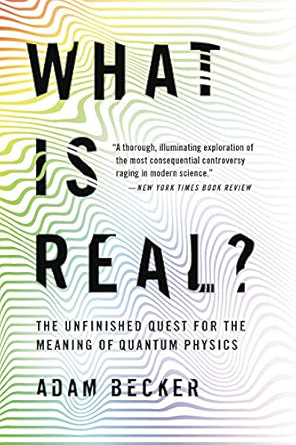More on this book
Community
Kindle Notes & Highlights
by
Adam Becker
Started reading
October 11, 2024
“What Schrödinger writes about the visualizability of his theory is ‘probably not quite right,’ in other words it’s crap.”
Bohr and Heisenberg pointed out that there were phenomena that seemed to demand quantum “jumps,”
Fundamentally, the problem was that the meaning of Schrödinger’s wave function was still not clear.
wave function collapses once measurement happens.
Born’s insight ultimately won him a Nobel Prize, and rightly so.
The measurement problem had arrived.
But Heisenberg knew you could find an electron using higher-energy light, with a shorter wavelength: gamma rays.
So you’ll know where the electron was, but you won’t know how fast it’s going or where it’s heading now.
he discovered that these limits on measurement were
fundamental: buried in the mathematics of his own matrix mechanics,
You could know a lot about where an object was or a lot about how it was moving—but you couldn’t know both at the same time.
Heisenberg, at twenty-five, became the youngest tenured professor in all of Germany.
Bohr found
true nature of the quantum world, which he called “...
This highlight has been truncated due to consecutive passage length restrictions.
Bohr started from the idea that “our usual description of physical phenomena is based entirely on the idea that the phenomena concerned may be observed without disturbing them appreciably.”
“any observation of atomic phenomena will involve an interaction with the agency of observation not to be neglected.”
“We are not dealing with contradictory but with complementary pictures of the phenomena,” claimed Bohr, which are “indispensable for a description of experience.”
When an electron is shot out into the tube, its wave function obeys the Schrödinger equation,
when the electron hits the phosphorescent screen, it hits in one location, lighting up a particular spot on the screen, like a particle.
sometimes the electron behaves like a wave, and sometimes it behaves like a p...
This highlight has been truncated due to consecutive passage length restrictions.
new quantum theory had shown it was impossible to give a single consistent account of an electron that would work at all times.
Position and momentum, like particles and waves, were complementary—never used at once but both needed for the complete description of a situation.
Bohr was convinced that complementarity was the deepest insight into nature found within the quantum theory.
We don’t know what that momentum is—but that’s certainly not the same thing as saying it doesn’t exist.
Complementarity] doesn’t provide you with any equations which you didn’t have before,” said the English physicist Paul Dirac. (Dirac wasn’t merely sniping—he had in fact discovered a new equation himself.
quantum field theory.
correctly predicted the existence of antimatter, a feat that would win him a Nobel Prize in 1933.)
The stage for the quantum showdown was set.
world by promoting scientific research. So, in 1911, Solvay used his money to organize a conference on the nascent quantum theory in his native Belgium.
Seventeen of the twenty-nine attendees had won or would go on to win Nobel Prizes;
Ultimately, Bohr prevailed, and the rest of the physics community accepted that quantum physics was correct and that the Copenhagen interpretation was the correct way to understand it.
Einstein never accepted the new theory, and until the day he died he insisted that nature could not be fundamentally random. Thus, the fable concludes, even the greatest and most famous physicists can still be wrong.
the truth is entirely different, and far more interesting, than the standard fable suggests.
Louis de Broglie,
to suggest that all of the fundamental constituents of matter had both a particle and a wave aspect.
Einstein replied enthusiastically, declaring that de Broglie had “lifted a corner of the great veil,” and de Broglie got his doctorate.
Broglie presented a new idea.
Broglie offered a quantum world where particles and waves lived in a peaceful coexistence, with particles surfing along “pilot waves” that govern their motion—
experiment could reveal a particle’s full trajectory, just as Heisenberg had said.
Wolfgang Pauli was quick to object.
Soon after the conference, de Broglie himself gave up on his ideas, for reasons related to Kramers’s objection.
Born and Heisenberg spoke next, presenting their matrix-based formulation
Bohr spoke, mostly rehashing his Como lecture, emphasizing that the wave and particle descriptions of quantum phenomena were complementary rather than contradictory:
Einstein rose to speak
Now, all eyes were on him as he walked up to the chalkboard to sketch out a simple thought experiment that contained a devastating critique of the Copenhagen interpretation.
Bohr himself had said
“truth was complementary to clarity,” and thus, they claimed, “Bohr was a very bad speaker, because he was too much concerned with truth”; similarly, “his sentences were long, involuted and opaque” because he “strove for precision.”)
cottage industry of theorizing about what was happening inside the head of one Niels Henrik David Bohr.
others have seen the influence of gnosticism in the contradictions of complementarity.
consistent strain of Marxism in Bohr’s writing and thoughts—


